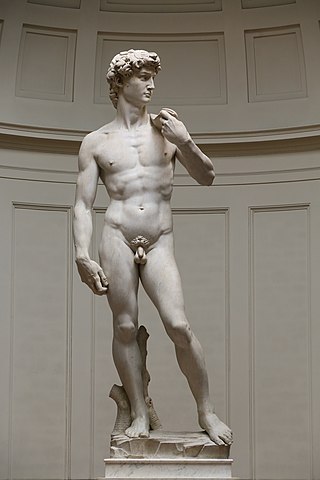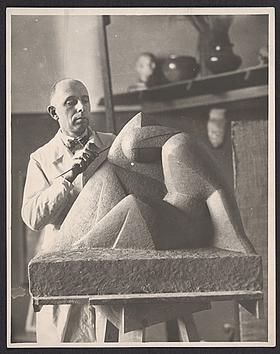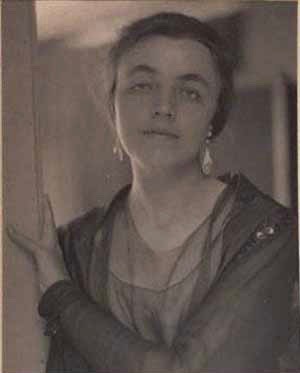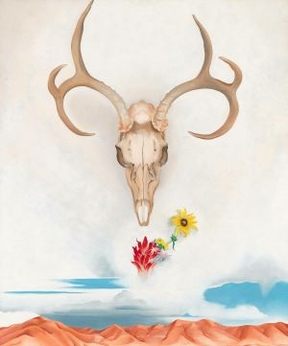
Expressionism is a modernist movement, initially in poetry and painting, originating in Northern Europe around the beginning of the 20th century. Its typical trait is to present the world solely from a subjective perspective, distorting it radically for emotional effect in order to evoke moods or ideas. Expressionist artists have sought to express the meaning of emotional experience rather than physical reality.

Pamela Colman Smith, nicknamed "Pixie", was a British artist, illustrator, writer, publisher, and occultist. She is best-known for illustrating the Rider–Waite tarot deck for Arthur Edward Waite. This tarot deck became the standard among tarot card readers, and remains the most widely used today. Smith also illustrated over 20 books, wrote two collections of Jamaican folklore, edited two magazines, and ran the Green Sheaf Press, a small press focused on women writers.
Events from the year 1925 in art.

Georgia Totto O'Keeffe was an American modernist painter and draftswoman whose career spanned seven decades and whose work remained largely independent of major art movements. Called the "Mother of American modernism", O'Keeffe gained international recognition for her meticulous paintings of natural forms, particularly flowers and desert-inspired landscapes, which were often drawn from and related to places and environments in which she lived.
291 is the commonly known name for an internationally famous art gallery that was located in Midtown Manhattan at 291 Fifth Avenue in New York City from 1905 to 1917. Originally called the "Little Galleries of the Photo-Secession", the gallery was established and managed by photographer Alfred Stieglitz.
American modernism, much like the modernism movement in general, is a trend of philosophical thought arising from the widespread changes in culture and society in the age of modernity. American modernism is an artistic and cultural movement in the United States beginning at the turn of the 20th century, with a core period between World War I and World War II. Like its European counterpart, American modernism stemmed from a rejection of Enlightenment thinking, seeking to better represent reality in a new, more industrialized world.

Nude photography is the creation of any photograph which contains an image of a nude or semi-nude person, or an image suggestive of nudity. Nude photography is undertaken for a variety of purposes, including educational uses, commercial applications and artistic creations. The exhibition or publication of nude photographs may be controversial, more so in some cultures or countries than in others, and especially if the subject is a minor.

The nude, as a form of visual art that focuses on the unclothed human figure, is an enduring tradition in Western art. It was a preoccupation of Ancient Greek art, and after a semi-dormant period in the Middle Ages returned to a central position with the Renaissance. Unclothed figures often also play a part in other types of art, such as history painting, including allegorical and religious art, portraiture, or the decorative arts. From prehistory to the earliest civilizations, nude female figures were generally understood to be symbols of fertility or well-being.

Arnold Rönnebeck was a German-born American modernist artist and museum administrator. He was a vital member of both the European and American avant-garde movements of the early twentieth century before settling in Denver, Colorado. Rönnebeck was a sculptor and painter, but is best known for his lithographs that featured a range of subjects including New York cityscapes, New Mexico and Colorado landscapes and Native American dances.

American Figurative Expressionism is a 20th-century visual art style or movement that first took hold in Boston, and later spread throughout the United States. Critics dating back to the origins of Expressionism have often found it hard to define. One description, however, classifies it as a Humanist philosophy, since it is human-centered and rationalist. Its formal approach to the handling of paint and space is often considered a defining feature, too, as is its radical, rather than reactionary, commitment to the figure.
Carolyn Burke is an Australian-born American writer, translator, and author of four biographies. Her first was a life of the English poet Mina Loy, published in 1996 and reprinted in 2021. She has also written books about the American photographer Lee Miller, the French chanteuse Edith Piaf, and the interwoven lives of four iconic figures of American art, Alfred Stieglitz, Georgia O’Keeffe, Paul Strand, and Rebecca Salsbury.

Katharine Nash Rhoades was an American painter, poet and illustrator born in New York City. She was also a feminist.
Fine art nude photography is a genre of fine-art photography which depicts the nude human body with an emphasis on form, composition, emotional content, and other aesthetic qualities. The nude has been a prominent subject of photography since its invention, and played an important role in establishing photography as a fine art medium. The distinction between fine art photography and other subgenres is not absolute, but there are certain defining characteristics.

Pornocrates, Pornokratès, La dame au cochon, or The Lady with the Pig is an 1878 painting by the Belgian artist Félicien Rops. It is part of the collection of the Musée provincial Félicien Rops in Namur, Belgium.

Georgia O'Keeffe made a number of Red Canna paintings of the canna lily plant, first in watercolor, such as a red canna flower bouquet painted in 1915, but primarily abstract paintings of close-up images in oil. O'Keeffe said that she made the paintings to reflect the way she herself saw flowers, although others have called her depictions erotic, and compared them to female genitalia. O'Keeffe said they had misconstrued her intentions for doing her flower paintings: "Well – I made you take time to look at what I saw and when you took time to really notice my flower you hung all your own associations with flowers on my flower and you write about my flower as if I think and see what you think and see of the flower – and I don't."

Black Iris, sometimes called Black Iris III, is a 1926 oil painting by Georgia O'Keeffe. Art historian Linda Nochlin interpreted Black Iris as a morphological metaphor for female genitalia. O'Keeffe rejected such interpretations in a 1939 text accompanying an exhibition of her work by writing: "Well—I made you take time to look at what I saw and when you took time to really notice my flower you hung all your own associations with flowers on my flower and you write about my flower as if I think and see what you think and see of the flower—and I don't." She attempted to do away with sexualized readings of her work by adding a lot of detail.

The American artist Georgia O'Keeffe is best known for her close-up, or large-scale flower paintings, which she painted from the mid-1920s through the 1950s. She made about 200 paintings of flowers of the more than 2,000 paintings that she made over her career. One of her paintings, Jimson Weed, sold for $44.4 million, making it the most expensive painting sold of a female artist's work as of 2014.

Maria Chabot (1913–2001), was an advocate for Native American arts, a rancher, and a friend of Georgia O'Keeffe. She led the restoration of her house in Abiquiú, New Mexico, and took the photograph of O'Keeffe entitled Women Who Rode Away, in which the artist was on the back of a motorcycle driven by Maurice Grosser. Their correspondence was published in the book Maria Chabot—Georgia O'Keeffe: Correspondence 1941-1949.

Georgia O'Keeffe - Torso, also known as Georgia O'Keeffe - Nude, is a black and white photograph taken by Alfred Stieglitz in 1918. It is one of the more than 300 photographs that he took of his future wife, the painter Georgia O'Keeffe.

Summer Days is a 1936 oil painting by the American 20th-century artist Georgia O'Keeffe. It depicts a buck deer skull with large antlers juxtaposed with a vibrant assortment of wildflowers hovering below. The skull and flowers are suspended over a mountainous desert landscape occupying the lower part of the composition. Summer Days is among several landscape paintings featuring animal skulls and inspired by New Mexico desert O'Keeffe completed between 1934 and 1936.














